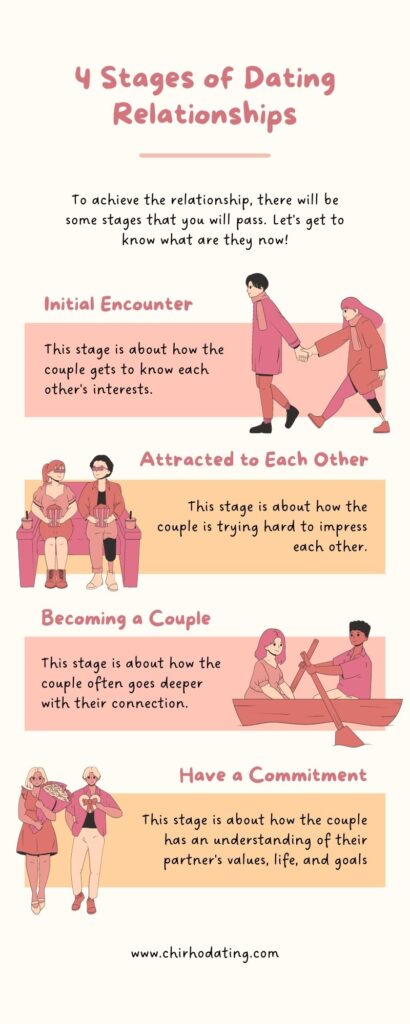We are a professional review company that receives compensation from companies whose products we review. We test each product thoroughly and give high marks only to the ones that are the very best. We are independently owned, and the opinions expressed here are our own.
In the intricate tapestry of love, relationships follow a journey as unique as the individuals involved.
Understanding the stages of a relationship timeline provides a roadmap for both men and women to traverse the challenges and joys that come with it.
Are you ready to get more knowledge about the different steps?
In this comprehensive guide, I’ll delve deep into each stage, offering insights, advice, and where you can find more helpful information to help you navigate the intricacies of love.
The Exciting Beginning
The journey of every relationship starts with a spark—an electrifying connection that makes your heart race. This is the “honeymoon phase,” characterized by the thrill of discovering each other’s quirks and charms.
Dates are filled with laughter and shared secrets; every moment feels like an adventure. This stage is essential for setting the tone of the relationship.
During the exciting beginning, focus on building a foundation of open communication. Engage in conversations that reveal your aspirations, interests, and values. This lays the groundwork for deeper connections as you move forward.
For more tips, please read the article about “First Date Conversation Starters” next.
Remember that while this stage is exhilarating, it’s also the time to understand each other’s expectations and intentions.

Building a Foundation
As the initial excitement settles, a more profound connection begins.
You’re no longer just exploring the surface—diving into each other’s pasts, dreams, and aspirations. Shared values and interests become the glue that binds you together. This is when you begin to see the potential for a lasting relationship.
During the foundation-building stage, embrace vulnerability.
Share your thoughts and feelings openly, allowing your partner to understand your true self. This is also the time to learn how to navigate disagreements.

Conflict resolution skills come into play as you work towards understanding each other’s perspectives and finding common ground.
Remember, a building built on sand can not last but will be raised.
Navigating Challenges
Every relationship encounters obstacles; this stage is about weathering the storms together. Disagreements arise, and differences in opinions become apparent.
How you navigate these challenges sets the tone for the relationship’s resilience. Effective communication is the key to keeping the connection strong.
In the face of challenges, take the time to listen actively.
Understand your partner’s viewpoint and express your thoughts with empathy. Remember that disagreements don’t indicate a lack of compatibility; instead, they provide opportunities for growth and compromise.
You can approach conflicts as a team and remember that your bond can emerge stronger from these experiences.
For tips on resolving relationship conflicts, please read the article “Navigating Marriage Problems” next.

Deepening Intimacy
As the relationship progresses, emotional and physical intimacy deepens.
You’re no longer just partners; you’re confidants. Trust is nurtured, and vulnerability is met with understanding.
Intimacy is about feeling safe to share your deepest fears, insecurities, and desires.
To foster intimacy, prioritize quality time together. Engage in activities that encourage meaningful conversations and shared experiences. Affectionate small and grand gestures remind your partner of your love and commitment.
Deepening intimacy also involves acknowledging boundaries and taking the time to understand your partner’s comfort zone.
Here are things you can do to deepen the intimacy between you and your partner.

Making Commitments
The stage of making commitments varies for every couple.
Some may choose to become exclusive, while others may discuss long-term plans. This stage is about transparency and aligning your visions for the future—open conversations about your relationship’s direction help avoid misalignments.
When making commitments, be honest about your feelings and intentions.
Discuss your goals and dreams, both individually and as a couple. Ensure that you’re on the same page regarding exclusivity, marriage, family, and other significant milestones.
Remember that healthy commitments are built on mutual respect and understanding.

Sustaining and Growing Together
A relationship’s longevity depends on how well you sustain and nurture it.
After the initial stages, the excitement may fade, but the depth of your connection grows. This stage requires ongoing effort to keep the relationship vibrant and fulfilling.
To sustain and grow together, prioritize each other’s well-being. Engage in activities you enjoy and make time for regular date nights. Continue discovering new facets of your partner’s personality to keep the relationship dynamic.
Encourage individual growth alongside shared experiences to keep the spark alive.
Facing Transitions
Transitions are inevitable in life, and they’re equally significant in relationships. This stage involves adapting to changes such as moving in together, career shifts, or family planning.
How you navigate these transitions as a couple shapes the trajectory of your relationship.
When facing transitions, communicate openly about your expectations and fears. Support each other through changes and remember that teamwork is essential.
In the article Fear of Rejection, I discuss it in more detail.
Be patient and understanding as you adjust to new circumstances together. The ability to adapt and face challenges head-on demonstrates the strength of your bond.

The Power of Communication
Effective communication is the golden thread that weaves through every relationship stage. It’s the foundation of understanding, trust, and growth. Without clear and honest communication, misunderstandings can fester and lead to more significant conflicts.
Incorporate active listening into your daily interactions.
Please pay attention to verbal and nonverbal cues, and encourage your partner to express themselves freely. Don’t avoid discussing complex topics; tackling challenging conversations can deepen your connection.
Remember that communication isn’t just about talking—it’s about genuinely hearing and understanding each other.
For more insights, you may want to read “Communication Is One of the Keys” next.
How the Stages of a Relationship Affects You
The stages of a relationship timeline create a beautiful tapestry of shared experiences, challenges, and growth.
From the electric excitement of the beginning to the profound intimacy of a committed partnership, every stage has its lessons and rewards.
Remember that every relationship is unique, and embracing the journey with an open heart fosters lasting connections.
As you navigate through these stages, remember that the essence of a healthy relationship lies in respect, understanding, and support. By fostering these qualities, both men and women can forge relationships that stand the test of time.

What’s Next?
Share your thoughts and experiences about the different stages of a relationship in the comments below.
Explore my other articles on love, communication, and maintaining healthy relationships for more insights on building strong connections that I share with you below.
To your success,




What do you think about the article you've just read? Please tell me below.